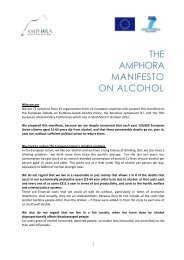Interpretations of Individualistic and Collectivistic ... - CSCanada
Interpretations of Individualistic and Collectivistic ... - CSCanada
Interpretations of Individualistic and Collectivistic ... - CSCanada
You also want an ePaper? Increase the reach of your titles
YUMPU automatically turns print PDFs into web optimized ePapers that Google loves.
Hellman M.,Gosselt J. F.,Pietruszka. M.,Rol<strong>and</strong>o S.,Rossetti S.,Wothge J.<br />
/Cross-cultural Communication Vol.6 No.4, 2010<br />
state. The antics <strong>of</strong> this ‘adorable jerk’ did not reverberate among the Italian pupils. The Italians also<br />
showed a great awareness <strong>of</strong> the negative consequences <strong>of</strong> excessive drinking <strong>and</strong> drunkenness.<br />
The second commercial produced ideas <strong>of</strong> sociability in all groups. It proved easy to relate to the social<br />
aspects <strong>of</strong> drinking. However, the advertiser’s message on the responsible adults did not meet the pitch <strong>of</strong><br />
the Finnish, German, Dutch <strong>and</strong> Polish adolescents, some (albeit not all) <strong>of</strong> whom saw the story ending with<br />
the group continuing drinking <strong>and</strong> partying. The German <strong>and</strong> Finnish pupils in particular had a strong<br />
tendency to finish the story in this fashion. Some Finnish pupils even suggested that the commercial was<br />
about a drinking bet <strong>and</strong> that the characters would get drunk ‘for sure’.<br />
The adult <strong>and</strong> responsible elements in the commercial’s stories on drinking found more favour with the<br />
Italian pupils. Intoxication seems to be a more familiar <strong>and</strong> ordinary state for the Finnish, German, Dutch<br />
<strong>and</strong> partly the Polish pupils. The basic messages <strong>of</strong> the romance <strong>of</strong> the couple <strong>and</strong> the togetherness <strong>of</strong> the<br />
group in the bar were something that all groups <strong>of</strong> pupils responded to. The correlations regarding<br />
individualistic <strong>and</strong> collectivistic drinking messages in the commercials are displayed in table 2.<br />
DISCUSSION<br />
From our material we have explored the informants’ ideas about drinking embedded in their interpretations<br />
<strong>of</strong> the commercials. The advertisers <strong>of</strong> beer transfer symbolic meaning <strong>of</strong> this specific consumer good by<br />
attaching the beer drinking to certain images. We have investigated the ways in which youngsters construe<br />
meaning about drinking in such commercial messages <strong>and</strong> we have highlighted some differences in the<br />
interpretations. We claim that these differences correlate with basic characteristics <strong>of</strong> drinking cultures,<br />
which can, roughly speaking, be seen as separating the Italian style from the rest. More sophisticated <strong>and</strong><br />
detailed differences would perhaps have been possible to discerned from an even larger data set that would<br />
solely have focused on cultural aspects in the discussions.<br />
On the basis <strong>of</strong> the study we can conclude that the pupils were stimulated by the images, which they<br />
utilized <strong>and</strong> negotiated partly to ‘see what they wanted’ or what they are culturally ‘programmed’ to see.<br />
They were more likely to interpret <strong>and</strong> emphasize drinking in the commercials in accordance with how<br />
drinking is viewed in their own culture. They were less likely to underline messages that they didn’t seem to<br />
be able to relate to. This appears to hold true even when the opposite message is as clearly pronounced as in<br />
the case <strong>of</strong> the second commercial (the ‘sincere’ friendship, the moderate drinking).<br />
More sophisticated br<strong>and</strong>-pr<strong>of</strong>iling messages do not seem to have the same degree <strong>of</strong> penetration as do<br />
the messages which correlate with the basic ideas about e.g. social dimensions <strong>of</strong> drinking. It could mean<br />
that those alcohol commercials that share the target audience’s views on drinking, are especially conducive<br />
to the flow <strong>of</strong> the message. If the correlation is high the flow should be high, <strong>and</strong> conversely, if correlation<br />
is low, the flow should work less well.<br />
Even though the statement above represents a somewhat simplistic view <strong>of</strong> the impact-process <strong>of</strong><br />
marketing, we are still able to draw some suggestive conclusions about the types <strong>of</strong> drinking messages that<br />
seem to be easier to agree upon in the different cultures. A larger degree <strong>of</strong> scepticism was expressed on<br />
messages whose meanings were not obvious, whereas basic emotional images such as social togetherness<br />
<strong>and</strong> joy were easy to identify with for all participants. In the second commercial, socialising <strong>and</strong> its<br />
importance were underscored by all the participating groups. In case <strong>of</strong> high correlation the participants<br />
would be more likely to draw conclusions regarding the format <strong>of</strong> the message <strong>and</strong> its aims: ‘it is supposed<br />
to show that it’s fun to drink together in company, it’s fun <strong>and</strong> sociable’ GER_M_93. ‘It’s seen like a way to<br />
get together, to have a beer is harmless <strong>and</strong> you don’t get drunk… it’s just a way to spend some time<br />
together’ (ITA_F_93). This would suggest that an underst<strong>and</strong>ing <strong>of</strong> a subtile dimension <strong>of</strong> the messages<br />
would correlate with an acknowledgement <strong>of</strong> the persuasive intent.<br />
The speech <strong>of</strong> the Italian pupils showed a higher correlation to the second commercial’s core message <strong>of</strong><br />
‘responsible’ drinking. They were also generally more critical to what they saw in the commercials. The<br />
Italian group discussions <strong>of</strong>ten demonstrated a high ability to make quite sophisticated judgements on the<br />
messages. The ability to recognize certain messages in the commercials seems to tally with an ability to<br />
53









